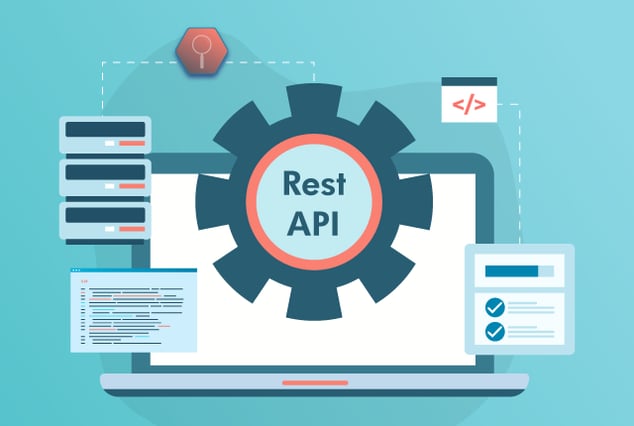
APIs have streamlined web development for software applications across industries, from startups to tech giants like Google, Twitter, Facebook, Dropbox and PayPal. No matter the size of your company or the complexity of your software product, strong web API testing practices are essential to ensuring the security of the application’s codebase as well as confirming that all expected interactions occur between the applications.
That’s a lot of boxes to check during QA testing, so where should your team start?
A strong testing process is the result of a solid strategy, so begin your web API unit test process by implementing a plan of action. Before we discuss how to test API during your testing cycle, let’s first answer your most pressing questions about web API testing, such as:
- What is an API?
- How does an API work?
- What are differences between web API and web services?
- What is REST?
- What are the best ways to overcome common web API testing challenges?
- What are the benefits of API testing?
What Is an API?
An API - which stands for Application Programming Interface - is a set of functions that allow your software application to access data and interact with external software systems or components. Think of an API as an intermediary between your software application and a third-party system so that both systems can support data integration and cross-collaboration across platforms. Web API testing is the process of ensuring that the API operates properly between systems.
How Does an API Work?
How APIs work is comparable to a dining experience at a restaurant. You are a customer reading the menu at your table and the kitchen is the provider of those menu items. But you as a customer cannot walk into the kitchen to place your order and take it back to your table. And the chefs don’t have time to take your order and deliver it to your table because they need to spend their time preparing your order.
That’s why restaurants have waiters. The waiter takes your order, delivers it to the kitchen and tells the kitchen how to prepare your order. The waiter then brings your food order back to your table.
This is comparable to how an API works. The API sends out your request to the external software resource and delivers its response back to you upon completion.
Web API vs Web Services: What’s the Difference?
A web service is a compilation of open source standards and protocols applied towards the exchanging of data between software applications or systems. This definition sounds similar to that of an API, so here’s how you can tell the difference.
In short, all web services are APIs - but not all APIs are web services. That’s because APIs have the ability to interact more progressively between two software systems and carry out more requests. A web service only uses SOAP, REST and XML-RPC as their three styles of communication while APIs can communicate more complexly. A web service is dependent upon a network in order to operate while APIs are functional without a network for operation.
What Is REST?
REST - which stands for Representational State Transfer - is a style of architectural for providing programming standards when developing web services so that systems can communicate more easily with each other.
REST-compliant systems (also known as RESTful systems) uphold these six guiding principles:
- Client-Server: REST separates the user interface from the data storage in order to improve the portability of the user interface across platforms as well as scalability through server component simplification.
- Stateless: Each request must contain all necessary information prior to delivery from client to server.
- Cacheable: All data within a response to a request must be labeled as either cacheable or non-cacheable. A cacheable response allows the client to reuse that response data for comparable requests in the future.
- Uniform Interface: REST enforces a simplified architecture in order to improve the visibility of interactions.
- Layered System: Hierarchical layers within the architecture can constrain component behavior so that each component has no insight beyond the immediate layer where their interactions occur.
- Code on Demand: This optional principle allows the extension of client functionality by downloading and executing code in the form of scripts or applets.
Web API Testing Challenges
Even expert QA engineers run into web API testing challenges during every development cycle. As your team becomes more familiar with how to test web API in browser, you will learn how to adjust to testing obstacles more quickly based on past troubleshooting and comfortability with the testing environment. Until then, here are ways on how your team can overcome API testing challenges with successful results.
-
Selecting the Right Web API Testing Tools
Testing a web API in browsers starts with having the correct tools. It can be tempting to choose the latest, priciest tool on the market, especially when it promises unparalleled results. But it can ultimately be a waste of time and money if it doesn’t deliver on quality and accuracy across every web API unit test.
Before your initial search, ensure that your team understands how to test API across your software application. Then review a variety of recommended API testing tools and ask yourself these questions during the decision-making process:
- Are the tools easy to use for all expected users?
- Do the tools feature functionalities beneficial and relevant to your team’s needs?
- Do the tools provide optimized workflows?
- Do the tools support all necessary formats and industry-specific protocols?
- Do the tools streamline the API test automation process?
- Are the tools easy to maintain and manage?
-
Incomplete Test Specifications
The process of testing a web API in browsers can stall when your QA testers do not have all the information needed to complete a web API unit test. For example, if requirements aren’t precise - numeric ranges not specified, date formatting not clarified - then it is impossible for your QA team to pass or fail a test case.
To overcome this challenge, refine your testing process. When drafting test cases, your QA engineer should notice when test information is incomplete. The project manager should then return to the business owner or client in order to provide all needed specifications for the test case to be executed. Furthermore, refining the procedures around gathering business requirements can help your team gather all specifications earlier in the development cycle so that all teams are on the same page.
-
Sequencing API Calls
API calls must appear in a specific order when testing API's. And it’s this specific sequencing that can cause your QA team challenges, especially when working with multiple-threaded applications.
For example, if an API call to return a user’s profile data is submitted before the profile is created, the request can expect an error message. Inversely, an error message occurs when requesting location pins on a map to be placed correctly if a call to create a map hasn’t yet been submitted.
Benefits of API Testing
You can confirm that your team knows how to test API based on the benefits received from the testing process. With the right web API unit test process in place, your team can expect to enjoy these advantages of web API testing across development cycles and projects.
- Ease of Access: Testers can detect and recognize errors earlier before they become larger issues.
- Cost-Effective: Because API test automation requires less coding, your team can enjoy faster test results more affordably.
- Stronger Security: The unique set of conditions and inputs within an API removes common vulnerabilities and adds more protection for your application.
- Language Independent: Since data is exchanged during an API tests uses JSON or XML, these transfer modes allow you to select any core language when partnering with an automated testing services provider for your software product.
- Simple Integration With GUI: Web API testing supports highly integrable tests, which are especially beneficial when your team executes functional GUI tests following your API testing process.
Here’s How To Test Web API
Web API testing can’t be effective if your team doesn’t understand how to test web API in browser. A strong API testing process should include these types of software testing to ensure that all API performance, functionality and security are in place.
- Validation Testing
- Functional Testing
- UI Testing
- Load Testing
- Runtime/Error Detection
- Security Testing
- Penetration Testing
- Fuzz Testing
- Interoperability and WS Compliance Testing
Still Not Sure How To Test API?
Can your team use some help with your web API testing process? Choose to partner with a QA services provider like QASource. Our team of engineers and testers have years of experience with API testing and specialize in implementing best API testing practices across your development cycle. Get a free quote today.


